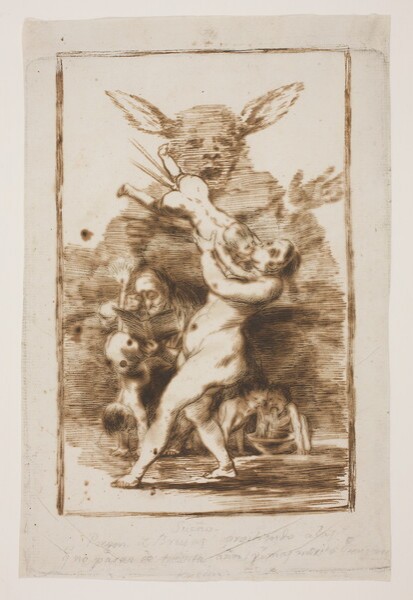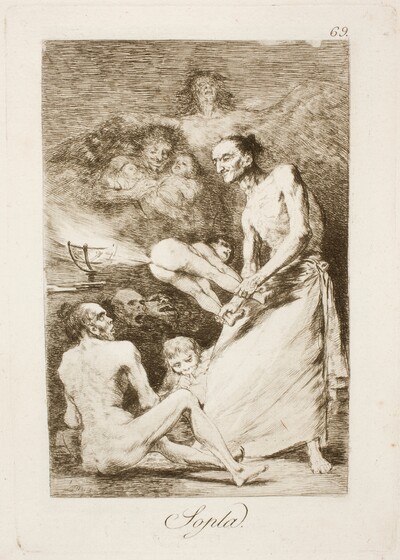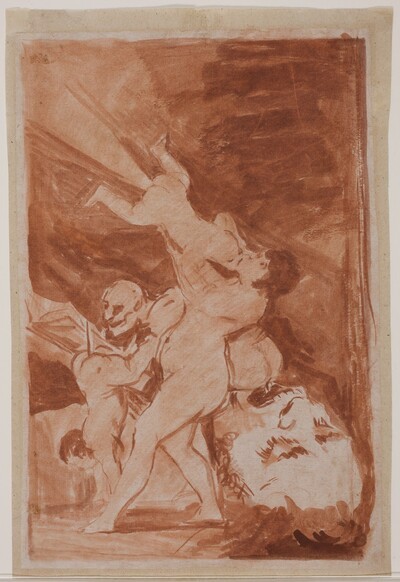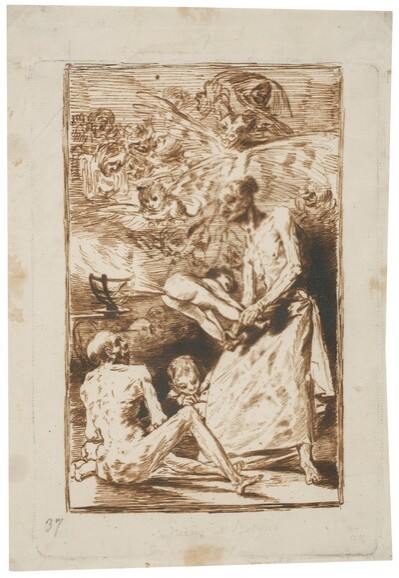- Cronología
- Ca. 1796 - 1797
- Ubicación
- The Prado National Museum. Madrid, Madrid, Spain
- Dimensiones
- 231 x 153 mm
- Técnica y soporte
- Reconocimiento de la autoría de Goya
- Documented work
- Titular
- El Prado National Museum
- Ficha: realización/revisión
- 22 Jul 2021 / 22 Jun 2023
- Inventario
- D4192
6 (in composite pencil; recto, upper middle)
Sueño. / Pregon de Brujas proibiendo a las / qe no pasan de treinta años, pr. mas merito qe tengan / en bolar (in composite pencil; recto, lower centre)
16 (in composite pencil; reverse, upper right-hand side)
Watermark: H C Wend / & / Zoonen [Large shield with helmet and letters "H [C] W" inside].
On the gestation, history and aims of the series known as Dreams, a set of preparatory drawings for The Caprices, see Dream 1: Universal Language.
Line of provenance of the present drawing: Javier Goya; Mariano Goya, 1854; Valentín Carderera, ca. 1861; Mariano Carderera, 1880; Prado Museum, 1886.
Framed by a black border, this drawing does not correspond to any sheet from the Caprices, but it is reported to have been made on copper, as the marks in the margins are still visible, which means it was engraved although no proof is known.
Following Moratín's writings on the practices of witchcraft, the painter, in some of the drawings in the Dream series and in the Caprices themselves, used as a thematic and compositional device the figure of the "child-fuelle", the protagonist of various scenes such as this one, Proclamation of Witches, Dream 7. Dream of witches consummated or Caprice 69. Blow. On this occasion, a naked woman with a bulging belly, probably a symbol of her sexual capacity, lifts one of these "bellows-children" into the air and blows her vital breath into his mouth, which he nevertheless expels forcefully from his backside. On the left, an old woman reads a book with glasses on, in front of which a child is doing a handstand. On the right, two children vomit simultaneously into a bowl. A huge figure in a Dominican habit and donkey's ears, a symbol of ignorance, presides over the scene from the background as he violently recites the witches' proclamation that gives the work its title. This is a veiled allusion to the Inquisition and its own proclamations.
Edith F. Helman suggests that this type of fantastical representation, especially those related to witchcraft, had a satirical purpose related to the political current affairs of Goya's time.
-
Madrid1999
-
Goya: Prophet der ModerneAlte NationalgalerieBerlin2005from July 13th to October 3th 2005. Exhibitied also at the Kunsthistorischemuseum, Vienna, October 18th 2005 to January 8th 2006, consultant editor Manuela B. Mena Marquéscat. 61
-
Goya: Luces y Sombras. Obras Maestras del Museo del PradoThe National Museum of Western ArtTokyo2011cat. 34
-
Goya luces y sombrasCaixaForumBarcelona2012consultant editors José Manuel Matilla and Manuela B. Marqués. From March 16th to June 24th 2012cat. 26
-
Los Caprichos de Goya y sus dibujos preparatoriosBarcelonaInstituto Amatller de Arte Hispánico1949p. 98
-
Trasmundo de GoyaMadridRevista de Occidente1963pp. 170-174
-
Vie et ouvre de Francisco de GoyaParísOffice du livre1970p. 186, cat. 625
-
Dibujos de Goya, 2 volsBarcelonaNoguer1975p. 82, cat. 45
-
El mundo de Goya en sus dibujosMadridUrbión1979pp. 120-121
-
MadridMuseo Nacional del Prado1999p. 349
-
Dumont2005p.185
-
MadridFundación bancaria “la Caixa” y Museo Nacional del Prado2012p. 142



